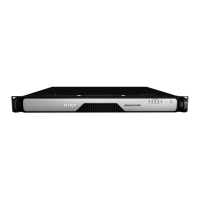Citrix SD-WAN Platforms
virtual networks. For one-arm operation, the second interface can be a stub, attached only to a VPX
VM.
A third virtual network interface provides an independent interface to the VPX VM, which is the equiv-
alent to the Primary port on a physical appliance. It can be used for the browser based interface, but
not for acceleration.
Other virtual machines
• Server resources beyond those allocated to VPX are available for other virtual machines on the
same server.
• Resource usage by other VMs eects VPX performance, and conversely. Acceleration makes in-
tensive use of CPU, memory, disk, and network.
Virtual network routing can be used to connect other VMs on the server to VPX VMs, but the simplest
method of connecting such VMs is to attach them to the server’s LAN-side Ethernet port. WAN-bound
packets then pass through the VPX VM’s bridge and are accelerated automatically, if they originate
inside or outside the server hosting VPX.
Figure 2. An Inline Deployment that Accelerates External Traic and Traic from Local VMs
Installing SD-WAN Virtual Appliances on XenServer
June 19, 2020
To install NetScaler SD-WAN virtual appliances on Citrix XenServer, you must first install XenServer
on a machine with adequate system resources. To perform the SD-WAN VPX installation, you use Cit-
rix XenCenter, which must be installed on a remote machine that can connect to the XenServer host
through the network.
Before you begin installing a virtual appliance, do the following:
• Install a supported version of XenServer® on hardware that meets the minimum requirements.
See the SD-WAN release notes for the supported versions of XenServer.
© 1999-2021 Citrix Systems, Inc. All rights reserved. 194

